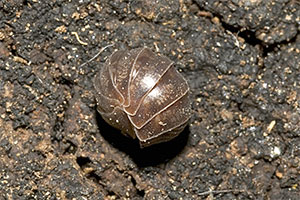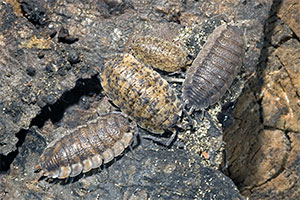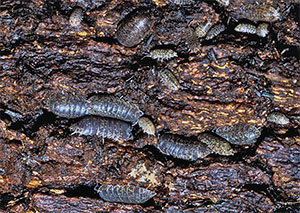|
Isopoda

Slater (woodlouse), native beech forest, New Zealand. Common name: slaters, pill bugs, sow bugs, woodlice, Maori papapa.
Scientific name:
phylum Arthropoda, class Crustacea, order Isopoda,
suborder Oniscidea. From Greek “iso”,
equal, and “poda”, legs.
Description
Slaters belong to the order Isopoda, which
is a part of the arthropod class Crustacea. Most crustaceans
– shrimp, crabs, lobsters, as well as many Isopoda
– are marine dwellers, but slaters (suborder Oniscidea)
have become fully terrestrial. Terrestrial Isopoda vary
slightly in appearance, but most are conspicuous and easily
recognised by their elliptical, flattened segmented bodies,
and seven pairs of legs.
Their colour is usually in the shades of grey, from dark to light, often mottled with green and yellow. Often there is a lot of variation in colour and pattern between individuals of the same species. The New Zealand slaters range in size from several millimetres to more than 2 cm, but most are 1.0-1.5 cm in length.

Slater rolled into a ball. Slater bodies are heavily armoured with
calcium carbonate and are quite rigid. The body is divided into
three regions - head, thorax, and abdomen, but these are far
less distinct than the head, thorax, and abdomen of insects.
Overall, the body has a smooth, rounded outline. The head
is small and covered with a single shield, sometimes with
rounded lobes or processes on the front margin. The head appears to
bear one pair of antennae, although there are actually two
pairs. The first two antennae are very small, inconspicuous,
and are thought to have a chemosensory function (smell and taste).
The second antennae are large and prominent, and have a tactile
function. On the sides of the head two eyes are visible; in some species the
eyes are composed of either a single ocellus (simple eye), in other species the eyes are larger, and have many closely associated ocelli (compound eye). Occasionally (e.g., in cave dwelling species), the eyes are absent. Chewing mouthparts
are located ventrally.
The largest part of the body is the thorax.
It is comprised of seven segments and covered with seven broad
overlapping dorsal plates (tergites), often with projections
at the sides. On the underside, each segment bears a pair
of walking legs. All legs are of similar size and structure,
hence the name Isopoda. The smaller hindmost region, not
always distinct, is the abdomen. The abdomen has 5 segments
(although only four plates are visible), and ends with a triangular
plate called the telson. Each abdominal segment also bears
a pair of legs, which are flattened and modified for respiration.
In male Isopoda the first pair of abdominal legs is modified
into copulatory organs. The last plate, the telson, bears a pair of short stout legs called uropods, which resemble
two short tails.
 Porcellio scaber
Porcellio scaber, an introduced species now common
throughout New Zealand. Porcellio does not roll
into a ball. When disturbed, some terrestrial Isopoda – the "pillbugs" – will roll themselves
into a ball, protecting the vulnerable ventral surface. You can
predict the ability of a slater to roll into a ball by looking
at its posterior body outline. If the prominent uropods are
visible, this slater probably does not roll into a ball, while
the ones with reduced uropods and smooth body outline do.
The New Zealand pillbugs can be confused with pill millipedes
(Diplopoda: Sphaerotheriida). Unlike Isopoda, pill millipedes
have 2 pairs of legs on each body segment, and are typically
shiny brown in colour.
Notes on biology
Slaters are mainly scavengers. They are
omnivorous, feeding on a variety of decaying vegetation,
tree bark, rotting wood, etc. Slaters may also graze on fungi
associated with decay, or consume dead animal matter, such
as dead insects or larger animal carcasses. Ant associates
feed on ant droppings and fungi. Although slaters usually
feed on dead and decaying vegetable matter and do not attack
living plants, they can sometimes eat seedlings and root vegetables,
or take advantage of fallen fruit previously damaged by birds
or insects. Chemical control against isopods is not necessary
– frequent removal of decaying plants and other hiding
places will keep them away.
Many animals – small mammals, birds,
centipedes, ground beetles – will eat terrestrial isopods.
The spider Dysdera crocata, often found in New Zealand
gardens, is said to prey on slaters almost exclusively. In defence,
some slaters secrete a noxious fluid, which makes them distasteful
and repels predators.
The isopod abdominal legs (pleopods) are
modified to form thin, plate-like gills. To function, these
gills need to remain covered with a thin film of water, which
is why slaters prefer damp, sheltered environments. The slaters
also lose water through the cuticle easily, and are very sensitive
to desiccation. Some species have internal breathing structures
called pseudotracheae (seen as small white patches on the
ventral side), and are more tolerant of dryness.

New Zealand Isopoda, side view. Most species reproduce sexually. Male and
female slaters mate during warm times of the year; the males
use modified abdominal legs to transfer sperm. The females
carry the eggs in a fluid-filled brood pouch between the bases of the legs, which protects the eggs and the
newborns from drying out. The eggs remain in the brood pouch
for a few weeks, the young slaters hatch within the pouch and
are released a few days later. The newly hatched slaters are
soft, white, and have only 6 pairs of legs. They gain the
7th pair of legs after their first moult. Like all arthropods,
slaters grow through a series of moults, expanding their body
while the new cuticle is still soft. Juvenile slaters resemble
adults, and moult at regular intervals until they reach sexual
maturity, usually within 1-2 years. The adult slaters continue
to moult, although less frequently. Slaters can live for
2-4 years, although most die as juveniles. The development
time and frequency of breeding differ between species.
Terrestrial Isopoda play an important role
in soil ecosystems. They shred dead and decaying organic matter,
mix the litter, disperse fungal spores, and produce numerous
faecal pellets. These activities enhance the decomposition process,
and speed up the recycling of soil nutrients. Most slaters in New
Zealand remain active throughout the year, but in
cold climates they may burrow down into the leaf litter, soil
or rotting wood to protect themselves from the frosts.
Where to find them?

Slaters (woodlice) in a native beech forest, New Zealand. Terrestrial Isopoda are among the easiest
soil animals to find and collect. They occur in a wide range
of habitats, and are particularly abundant in lime-rich soils,
as they need calcium to build their hard cuticle. Slaters
can be found in dark, damp, sheltered places in almost any
kind of environment. They spend the daylight hours congregated
under shelters, sometimes in large numbers; at night they
wander around in search of food, and even climb tree trunks. Look for them under logs,
in leaf litter, in rotting wood, under loose tree bark, under
garden debris, in compost heaps, under animal carcasses, under
rocks and bricks. Once uncovered,
slaters will try to escape the light, but they are not very fast
runners. Slaters do not bite.
If dried, slaters become very brittle and
will fall apart. If necessary, slaters can be preserved in
75% alcohol, although this will discolour them. Most species
will survive for many days in a sealed container with soil,
leaf litter, pieces of tree bark, or moss, placed in a cool
dark area (for example, the veggie section of the refrigerator).
Distribution and conservation
About 3,500 species of terrestrial Isopoda
have been described worldwide; many more species are probably
still undiscovered. Slaters have colonised some of the most
extreme environments, including Antarctica and Australian
deserts. In New Zealand, about 36 species of terrestrial
Isopoda are known. Slaters in New Zealand are common inhabitants
of nearly all environments. Native species can be found
in forested areas, grasslands, coastal dunes; several introduced
species are inhabitants of disturbed areas and are very
common in parks, gardens, and on farmlands. A pale coloured
Styloniscus commensalis lives in ant nests.
Slaters are easily transported with plants,
soil, and garden materials. Several common European species
are synanthropic (prefer human-modified habitats), and have
become well established in gardens and farmlands of New Zealand.
Two introduced species, Armadillidium vulgare and
Porcellio scaber, are particularly common around
New Zealand. European Oniscus asellus has been placed
on the New Zealand list of invasive species as a regulated pest.
Many of the native species are probably confined to protected
native forests. Currently, there is no conservation program
directed on terrestrial Isopoda in New Zealand.
Included images:
- Family Porcellionidae
- Porcellio scaber
Latreille, 1804* - Rabbit Island, NN, South Island
- Porcellio scaber
Latreille, 1804* - Kaiteriteri Road, NN, South Island
- Other
- Unidentified species - Kaikawa scenic Reserve, ??, North Island (2 images)
- Unidentified species - Ohinetonga Scenic Reserve, TO, North Island
- Unidentified species - Rimu Valley Walk, SD, South Island (2 images)
- Unidentified species - Nelson, NN, South Island (3 images)
- Unidentified species - Blue Duck Reserve, KA/NC, South Island
- Unidentified species - Kawhatau Base, RI, North Island
- Unidentified species - Peel Forest, Dennistoun Bush, SC, South Island (3 images)
- Unidentified species - Temple Valley, Lake Ohau, MK, South Island
- Unidentified species - Tautuku Estuary, Caitlins, Southland, SL, South Island (3 images)
- Unidentified species - Trounson Kauri Park Northland, ND, North Island (2 images)
- Unidentified species - Palmerston North, WI, North Island (2 images)
- Unidentified species - Palmerston North, WI, North Island (2 images)
- * - species exotic in NZ
Further information on New Zealand
terrestrial Isopoda:
Chilton, C. 1901. The terrestrial Isopoda
of New Zealand. Transactions of the Linnean Society of London,
2 (Zoology) 8, p. 99-152.
Hopkin, S.P. 1991. A Key to the Woodlice of Britain and Ireland.
56 pp.
Hurley, D.E. 1961. A Checklist and Key
to the Crustacea Isopoda of New Zealand and the Subantarctic
Islands. 34 pp.
Lewis, F. 1998. New genera and species
of terrestrial Isopods (Crustacea: Oniscidea) from Australia.
Journal of Natural History 32(5), p. 701-732.
Pugh, P.J.A., Dartnall, H.J.G, McInnes,
S.J. 2002. The non-marine Crustacea of Antarctica and the
Islands of the Southern Ocean: biodiversity and biogeography.
Journal of Natural History 36(9), p. 1047-1103.
Isopoda Resources on the Web
NZ Slaters: A Guide and Key to Terrestrial Isopoda of New Zealand
WoRMS - Isopoda
Bug Guide - Isopoda
Gordon’s
Woodlice page, by Gordon Ramel, contains facsinating facts
on biology of terrestrial Isopoda, including instructions
on how to keep Isopoda as pets.
Isopoda:
Slaters, CSIRO, short description of morphology, life
cycle, and ecology of slaters. Includes dictionary of terms.
The
Tree of Life: Isopoda, description of phylogenetic relationships
within Isopoda, their morphology and ecology; mostly dedicated
to marine species.
|